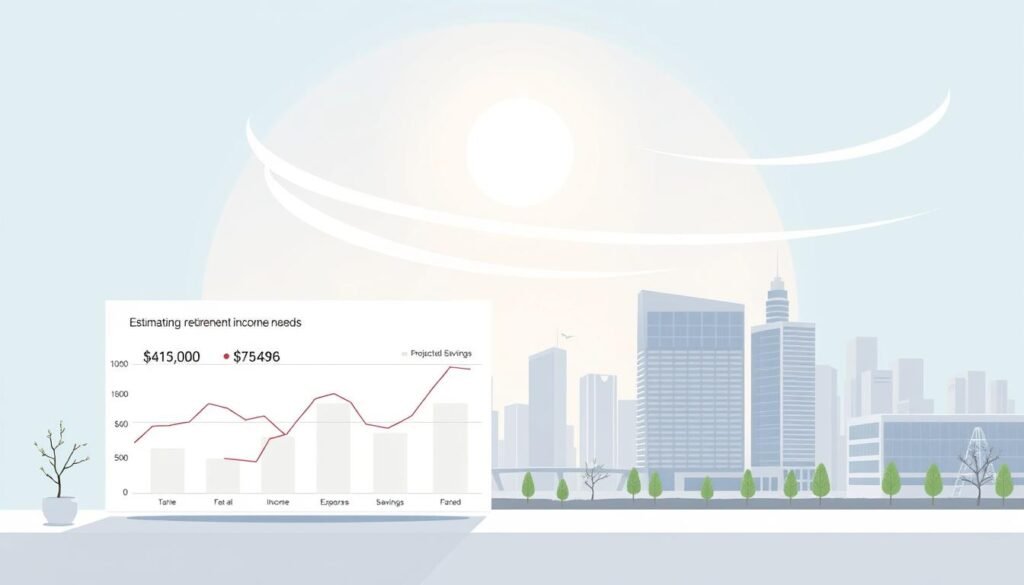
Expert Retirement Planning Tips Canada Professionals Rely On

Imagine a map worn at the edges. You open it on a kitchen table, coffee steaming, and see the route from today to a calmer future. That map is what a good plan gives you: direction and less stress.
I once met Sarah, who worried about rising housing costs and health bills. She met a financial advisor who helped turn fears into steps. They set goals, checked timelines, and used simple calculators to estimate how long her money might last.
This section shows why a clear approach matters now. You’ll learn how to match investments to your time horizon and risk comfort. You’ll also see practical ways to balance cash flow, debt and savings so the choices you make today fit your values.
Expect friendly, step-by-step guidance that highlights the benefits of working with an advisor and using tools to stay on track.
- Start your plan with a clear retirement vision and timeline
- How to estimate your retirement income needs in Canada
- retirement planning tips Canada professionals
- Where to save and invest: RRSP, TFSA, and workplace pension plans
- Turn savings into retirement income: CPP, OAS, RRIFs, LIFs and more
- Protect your nest egg: risk management, health, and security
- Your next steps to keep retirement on track in Canada
Start your plan with a clear retirement vision and timeline
Decide on an initial age to stop full-time work and use it as a planning anchor. That single choice helps you answer three core questions: what age do you want retire, when can you start saving, and which income sources will support you.
Set a placeholder age so your math has a fixed endpoint. Treat it as adjustable—life and finances will bring changes, and you should revisit the date as needed.
Map the lifestyle you want in your retirement years. List where you’ll live, how much you’ll travel, and what hobbies or care needs will affect your spending. Translate those choices into dollar estimates for big items like moving or renovations.

- Pick a tentative age to anchor your savings and revisit it when career, family or health shift.
- Sketch daily life, then turn hobbies and travel into numbers to test feasibility.
- Set annual milestones to review your time horizon, risk, and goals with an advisor.
| Question | Action | Result |
|---|---|---|
| What age do you aim for? | Choose a placeholder age | Anchor calculations and savings rate |
| How will you spend your years? | List lifestyle choices and big costs | Estimate budget and gaps |
| How often to review? | Set annual check-ins or after major events | Keep the plan aligned with life changes |
How to estimate your retirement income needs in Canada
Begin with a short snapshot of three to six months of actual spending to find the real numbers. Track every bill, subscription and grocery trip so you know where your money goes today.
Separate fixed costs (mortgage, insurance, utilities) from flexible costs (travel, dining). This helps you model different scenarios and adjust the amount you need later.

List income sources and use Canadian calculators
Make a full list: employment pensions, personal savings and government benefits like CPP, OAS and GIS. Remember you must apply for CPP and OAS; apply for CPP about nine months before you stop work to avoid delays.
Use a Retirement Budget Calculator to compare income and expenses. Then run a Retirement Cash Flow Calculator to see monthly cash flow from savings, pensions and programs.
- Model earlier or later CPP/OAS start dates to see how the amount changes.
- Factor inflation, higher health costs and lower returns into every scenario.
- Create a short summary that compares projected income to expected expenses so any gap is clear.
| Step | Tool | Outcome |
|---|---|---|
| Track 3–6 months spending | Budget Calculator | Baseline monthly needs |
| List income streams | Cash Flow Calculator | Projected monthly income |
| Model scenarios | Range of returns & inflation | Gap size and action plan |
retirement planning tips Canada professionals
Build steady saving habits before you need them. Start by automating contributions so saving happens on schedule. Automatic payroll deductions use dollar-cost averaging to smooth market swings and remove emotional timing errors.

Build saving habits: automate contributions and dollar-cost averaging
Automatic deposits make saving simple. They help you keep retirement goals on track without constant effort.
Dollar-cost averaging lets you buy into the market at regular intervals. This reduces the risk of buying at a peak and keeps your investment consistent over time.
Balance RRSP, TFSA, and workplace pension contributions
Check employer matching first it can effectively double your contributions. Then split new savings across RRSP, TFSA and workplace plans so each dollar works hard for your plan.
Group plans often charge lower fees because costs are shared across many members. Regular reviews with an advisor help you adjust contributions after job or life changes.
"Capture the employer match, keep fees low, and automate contributions small steps that add up to big results."
- Set a monthly or bi-weekly cadence that fits your cash flow.
- Prioritize full employer matching before other top-ups.
- Compare group plan fees versus retail accounts to keep more of your money compounding.
- Book periodic check-ins with an advisor review after major changes.
Where to save and invest: RRSP, TFSA, and workplace pension plans
Where you put your money matters as much as how much you save. Choose accounts that match your pay cycle, tax position and how soon you will need access.
Registered Retirement Savings accounts like the RRSP let you make tax-deductible contributions while you earn. Withdrawals are taxable later, so an RRSP can lower your current taxable income while you build a nest egg.
The TFSA does the opposite. Contributions are not tax-deductible, but growth and withdrawals are tax-free. Use a TFSA for flexible access and to shield some investments from tax on withdrawal.
At work, group RRSPs, pension plans and other savings plans offer payroll deductions and lower fees. Employer matching boosts your contributions and is often the fastest way to grow retirement savings.
- Understand defined benefit versus defined contribution: one promises an income formula, the other depends on contributions and investments.
- Check fees, investment options and beneficiary rules on each account.
- Split contributions to balance current tax benefits and future withdrawal flexibility.
Turn savings into retirement income: CPP, OAS, RRIFs, LIFs and more
When it’s time to turn decades of saving into steady income, small timing choices make a big difference. Start with a clear timeline for government benefits and your registered accounts so you can smooth cash flow and taxes.
Apply on time for CPP, OAS, and assess GIS eligibility
CPP can begin at 60 with a reduced amount or be delayed past 65 to increase payments. Apply about nine months before your planned stop date to avoid gaps.
OAS normally starts at 65 and depends on residency and income. If your projected income is low, check GIS it can add meaningful monthly benefits for those 65 and older.
Convert accounts and consider annuities
Convert your RRSP to a RRIF to start regular withdrawals. Use a LIF for locked-in pension funds from a LIRA or RPP so money flows legally and predictably.
Consider an annuity for part of your savings if you want guaranteed income for a set number of years or for life.
Tax-smart withdrawals and beneficiary steps
Sequence withdrawals across TFSA, RRIF, non-registered accounts and workplace pension to manage tax and avoid OAS clawbacks.
Set or verify beneficiaries now. If your spouse is the RRIF beneficiary, the transfer can occur tax-deferred; otherwise the RRIF value may be added to your final year income.
| Action | Why it matters | When |
|---|---|---|
| Choose CPP start | Affects monthly amount | Decide before 60–66 |
| Convert RRSP → RRIF / LIF | Creates steady income | By age 71 or earlier |
| Set beneficiaries | Preserves tax deferral | Now, and after life changes |
- Coordinate any defined benefit pension start date with other income to smooth years of transitions.
- Review withdrawal amounts annually with an advisor to adjust for markets, inflation and changing needs.
Protect your nest egg: risk management, health, and security
Unexpected costs can erode years of careful saving if you do not build simple safeguards first. Start with clear, low-effort steps that shield your money and your health.
Emergency fund, insurance review, and long-term care planning
Set aside cash that covers 3–6 months of essential bills. An emergency fund stops you from selling investments at a loss when you face a sudden expense.
Review insurance home, auto, life, critical illness, long-term care and travel medical so coverage matches your current needs. Talk to a financial advisor for gaps and overlaps.
Think through health changes and mobility needs for future years. Factor likely care costs into your planning so choices today help keep retirement secure.
Fraud prevention: scam awareness, checklists, and trusted contacts
Protect accounts with strong, unique passwords and two-factor authentication. Use fraud checklists and be wary of unsolicited offers that promise outsized benefits.
- Keep a Trusted Contact Person on file so your advisor can act if there are concerns.
- Review beneficiary designations across plans and your pension to match your will.
Power of attorney and an up-to-date will
Appoint powers of attorney and refresh your will to ensure your wishes are clear. Store key documents where a trusted family member or professional can find them.
These steps help you keep retirement savings and benefits safe and make it easier for loved ones to act when needed.
Your next steps to keep retirement on track in Canada
Pick a clear endpoint for your work life so you can test goals, income and savings choices against a real date.
Quick checklist to act on now: confirm your placeholder date and lifestyle, track spending for 60–90 days and use a budget and cash‑flow calculator, and list all income sources workplace pension plan, registered pension accounts, CPP, OAS, GIS, RRSP/RRIF/LIF, TFSA and non‑registered funds.
Then top up TFSA or rrsp contributions as needed, revisit investment choices in each account, set beneficiary rules (include spousal RRIF rollover options) and build a withdrawal sequence to manage tax and benefits.
Finally, update POA, will and insurance, set a Trusted Contact Person, automate contributions and book a review with your advisor about nine months before you plan to apply for CPP.
If you want to know other articles similar to Expert Retirement Planning Tips Canada Professionals Rely On you can visit the category Investing.






Leave a Reply